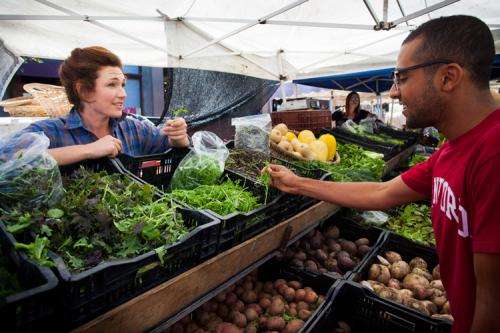Students create interactive tool that tells the story of global change

An innovative project led by Stanford students harnesses the power of first-person and local news stories – presented in an interactive online map – to help people grasp the science of global environmental impacts on their communities.
The project was developed during spring quarter 2014 as part of Biology 128: Geographic Impacts of Climate Change: Mapping the Stories. Under the guidance of Elizabeth Hadly, a biology professor and senior fellow at the Stanford Woods Institute for the Environment. Biology graduate students Alexis Mychajliw and Melissa Kemp led the undergraduate class.
The topic areas were drawn from a scientific consensus statement Hadly co-authored and hundreds of international scientists signed last year. Completed at the urging of California Gov. Jerry Brown, the statement translates key scientific findings from disparate fields into one unified message for policymakers, industry and the general public.
Using these topics as a guide, undergraduate students Simone Barley-Greenfield, Osama El-Gabalawy, Jason Kaufman, Job Nalianya and ZiXiang Zhang researched relevant stories within specific areas of the state, interviewed area residents, then integrated the data into the map using geographic mapping software, ArcGIS.
The Biology 128 course involved partnerships with the Environmental Systems Research Institute for help with ArcGIS. Stanford's Community Engaged Learning Program, which operates out of the university's Haas Center for Public Service, helped with connecting students and instructors with stakeholders around California.
"As an interactive tool, this map allows viewers to dive into local issues without spending hours on a search engine or wading through a report," said Barley-Greenfield, a sophomore majoring in marine biology.
In addition to climate impacts, the map's data can be filtered by four other topics: population, biodiversity, invasive species and diseases, and pollution. The map weaves together scientific data layers, such as changes in average precipitation and rates of forest loss, with more than 600 local news stories and multimedia content on topics ranging from marijuana farms' water use to a coyote-hunting contest's threat to endangered wolves. Users can access the stories by clicking on spots color-coded by stakeholder represented – farmers, business owners and recreational users, among others.
The map currently features news stories that quote local residents and will eventually include interviews conducted by Stanford students, as well as audio and video clips submitted by Californians.
"It gives local people ways to understand what's happening to our planet," said Mychajliw. "It's an alternative way to communicate what we know to people who are making decisions," Kemp added.
Hadly, Mychajliw and Kemp plan to build the map into a more interactive and comprehensive storytelling tool that spans the country. They envision the map as a potentially powerful educational platform that school students can not only learn from but add to.
In the meantime, Californians can use the map to get a better grasp on the science of global environmental change. "This project is about how global issues play out in real time on a local scale with real people's lives," said Hadly, the Paul S. and Billie Achilles Professor in Environmental Biology.
Although a work in progress, the project has already attracted the attention of Brown's office. The story map is featured on the Governor's Office website, and Mychajliw and Kemp have been invited to strategize with the governor's office on how policymakers, businesses, educators and the public can most effectively use the tool.
"The map shows how climate is affecting people in all different parts of the state and sectors of the economy," said Louise Bedsworth, deputy director of the Governor's Office of Planning and Research. "First-person perspectives are valuable to make it relatable to people, not just some distant future thing. I look at it as a resource to pull in these perspectives. It's all in one place. That's a tremendous value."
Provided by Stanford University



















